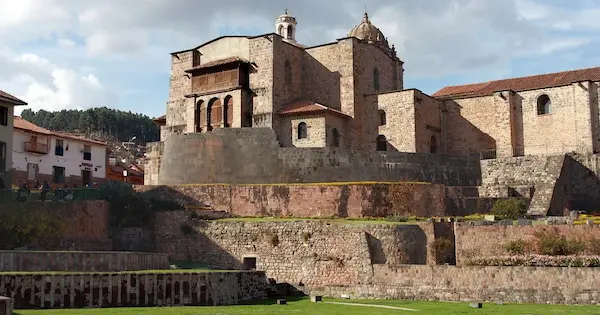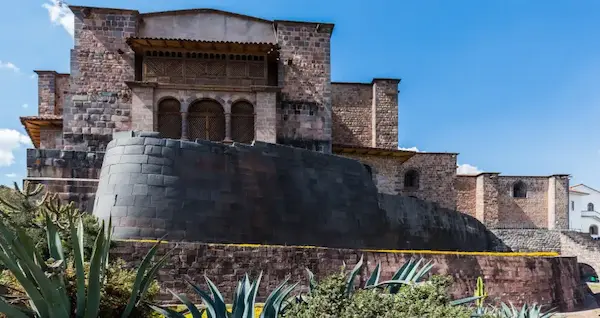Av Retamayoc L-10, San Sebastián 08002
- +51 940 809 144
- Travel Blog
- About Us
- Contact Us
Av Retamayoc L-10, San Sebastián 08002
Chat to a Andean Road Peru
The Koricancha, also known as the Temple of the Sun, was the most significant religious site in the Inca Empire. Located in the center of Cusco, it stood as a monumental symbol of reverence for Inti, the Sun god. Its architecture and purpose highlighted the deep connection between the Inca rulers and the divine, showcasing their power and influence.
Koricancha, which translates to "Golden Courtyard" in Quechua, perfectly reflects its original splendor. The temple’s walls once gleamed with gold, shining brightly under the sun. Following the Spanish conquest, much of the gold was removed, and the Santo Domingo Church was built over the temple's ruins.
In addition to its religious role, the Koricancha housed the mummies of former Inca rulers, central to Inca religion. The Incas carefully preserved and revered these mummies, believing they held spiritual power. They viewed the rulers as divine, even in death, consulting the mummies during ceremonies. The mummies' presence in Koricancha, along with rituals, showed the deep respect the Incas had for their ancestors.
Walking through the Inca streets of Cusco today, visitors can still see the remnants of this sacred path. The smooth stones, expertly fitted together without mortar, reflect the precision of Inca construction. As one approaches the Koricancha, these walls reveal the grandeur of the original architecture.
Over time, the importance of the mummies and idols led to the Koricancha becoming the heart of religious life in Cusco. Pilgrims from all across the empire made their way to the temple to pay homage to the gods and seek guidance from the powerful mummies of their ancestors.
Maybe you’d like to read: Chinchero: A glimpse into the living inca culture

The Koricancha was a masterpiece of Inca craftsmanship. Stones used in constructing the temple came from distant quarries, most notably Huacoto and Rumicolca. These quarries provided the andesite stone, known for its durability and ability to hold fine, precise edges when cut. The Incas did not use mortar to bond their stones, but instead, carefully shaped each block to fit perfectly with its neighbors. The result was a structure that stood the test of time, and many of these walls remain intact today.
One impressive aspect of Koricancha’s construction was its sophisticated stonework. The Incas carved stones with precision, fitting them seamlessly without mortar. The intricate design, especially in niches and walls, highlighted Inca technical skill. The temple's smooth stones and geometric shapes represented their understanding of architecture and belief in harmony between man-made structures and nature.
The Incas designed ritual spaces in Koricancha to connect the earth, the sun, and the people. Water channels flowed through the temple, enhancing the spiritual experience. Incan architecture used water to represent life, fertility, and purification. These channels symbolized life’s essence and the fertility cycle, integrating with the temple’s spiritual and physical aspects. The placement of water channels aligned with astronomical events, like solstices, emphasizing the temple's cosmic significance.
The Koricancha was also significant in marking the cycles of the moon and Venus. The Incas were keen astronomers who observed the stars and planets closely. Venus, as the brightest object in the sky, held particular importance in their religious practices. The alignment of the Koricancha with celestial events reinforced the idea that the temple was not only a sacred place on earth, but also a bridge to the heavens.
Excavations at the Koricancha uncovered numerous offerings left by the Incas to honor the gods and ensure the empire's prosperity. These items included finely crafted shells, gold and silver artifacts, ceremonial vessels, and textiles. The offerings symbolized the Incas' gratitude toward their gods and reinforced the belief that the divine played an ever-present role in their daily lives.
The Incas believed that the sun’s rays were a source of life and prosperity, and the Koricancha was a place to channel these rays into their daily lives. The temple’s design, astronomical significance, and precious offerings reflected this deep connection between the sacred and the material world.
Maybe you’d like to read: Visiting Pisac ruins: A Journey through history and culture

The Koricancha was not only a religious site, but also a key hub of the Inca Empire. It was strategically located at the center of Cusco, the capital of the empire, and served as a focal point for the Inca’s vast network of roads and sacred sites. The Koricancha was at the intersection of multiple ceques, or sacred lines, that radiated out from the temple to other important religious locations across the empire. The Incas aligned the ceques with natural features like rivers and mountains, reflecting their belief in the connection between the sacred and natural worlds.
Today, visitors to Cusco can still see remnants of the Koricancha beneath the Santo Domingo Church, which the Spanish built over the temple's ruins. The colonial architecture of the church contrasts sharply with the precision and grandeur of the original Inca temple, creating a fascinating blend of two distinct cultural traditions. Although the Spanish removed most of the gold, Koricancha's architectural and spiritual importance remains, offering a unique glimpse into the past.
For those interested in exploring this remarkable piece of history and experiencing the rich legacy of the Incas firsthand, Peru offers countless opportunities. Working with a Peru tour operator ensures a deeper understanding of the history, culture, and significance of places like the Koricancha. With expert guides and customized itineraries, a tour operator can enrich your journey, providing insights into the ancient marvels of the Inca Empire and beyond. Whether you're visiting Cusco or other sacred sites across the country, the expertise of a local tour operator will bring Peru’s vibrant history to life.
Koricancha, also known as the Temple of the Sun, was the most important religious site in the Inca Empire. It was dedicated to Inti, the Sun god, and served as a central location for religious ceremonies, astronomical observations, and offerings. It also housed the sacred mummies of Inca rulers and revered idols from across the empire.
Koricancha was once covered in sheets of pure gold, which reflected its name, meaning "Golden Courtyard" in Quechua. The gold-covered walls symbolized the wealth and power of the Inca Empire. However, after the Spanish conquest, most of the gold was taken, and the Santo Domingo Church was built over the ruins.
Koricancha is known for its advanced stone masonry, where large blocks of andesite were cut and fitted perfectly without mortar. The walls were built with an inward tilt, a technique that made them resistant to earthquakes. Niches and windows within the temple were precisely aligned, showcasing the Incas' exceptional architectural and engineering skills.
Yes, visitors can see parts of the original Koricancha structure beneath the Santo Domingo Church in Cusco. The lower sections of the temple, including the stone walls and niches, remain intact. These remnants offer a glimpse into the grandeur of the ancient Inca temple.
Leave a comment